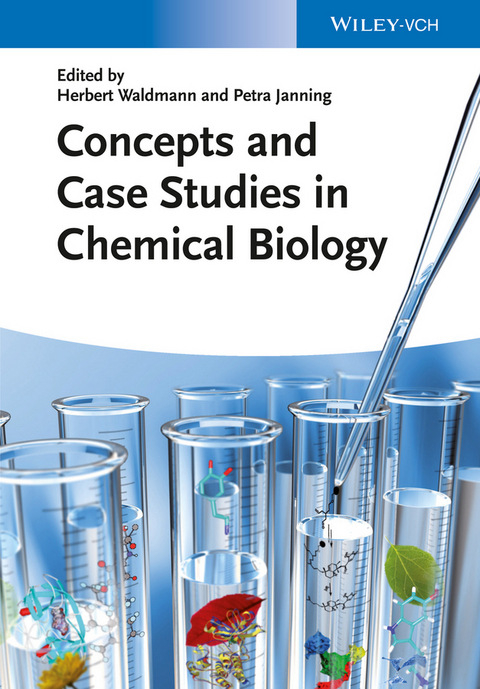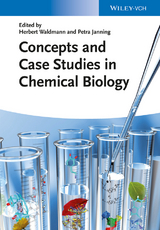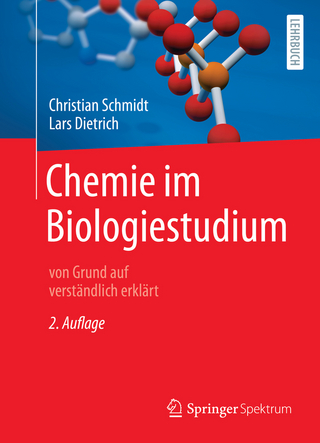Concepts and Case Studies in Chemical Biology
Wiley-VCH (Verlag)
978-3-527-33611-1 (ISBN)
- Titel ist leider vergriffen;
keine Neuauflage - Artikel merken
Edited by two of the world's leading researchers in the field, this textbook introduces students and researchers to the modern approaches in chemical biology, as well as important results, and the techniques and methods applied. Each chapter presents a different biological problem taken from everyday lab work, elucidated by an international team of renowned scientists.
With its broad coverage, this is a valuable source of information for students, graduate students, and researchers working on the borderline between chemistry, biology, and biochemistry.
Herbert Waldmann obtained his PhD in organic chemistry from the University of Mainz, Germany, in 1985 working with Professor H. Kunz, after which he completed a postdoctoral appointment with Professor G. Whitesides at Harvard University (USA). He was appointed as Professor of Organic Chemistry at the University of Bonn (1991), full Professor of Organic Chemistry at the University of Karlsruhe (1993), and Director at the Max-Planck-Institute of Molecular Physiology Dortmund and Professor of Organic Chemistry at the University of Dortmund, Germany, in 1999. He has received numerous awards, e.g. the Otto-Bayer-Award (2001), the Max Bergmann Medal (2003), and recently the Emil-Fischer-Prize (2012). His research interests lie in bioactive compound development, target identification, and the chemical biology of Ras proteins.
Petra Janning studied chemistry at the University of Münster, Germany, and did her PhD thesis at the Institute for Analytical Sciences in Dortmund, Germany in 1995. After different positions where she worked in the area of analytical chemistry and on the borderline between chemistry and biology she joined the Max-Planck-Institute of Molecular Physiology, Dortmund, in the department of Professor H. Waldmann, where she is currently working. She is responsible for the Bioorganic Practical Course and the analytics in the department. She focused her work on mass spectrometry based methods in proteome research, in particular in target protein identification of small molecules.
1. Real-Time and Continuous Sensors of Protein Kinase Activity Utilizing Chelation-Enhanced Fluorescence
2. FLiK and FLiP: Direct Binding Assays for the Identification of Stabilizers of Inactive Kinase and Phosphatase Conformations
3. Strategies for Designing Specific Protein Tyrosine Phosphatase Inhibitors and their Intracellular Activation
4. Design and Application of Chemical Probes for Protein Serine/Threonine Phosphatase Activation
5. Autophagy: Assays and Small Molecule Modulators
6. Elucidation of Protein Function by Chemical Modification
7. Inhibition of Oncogenic K-Ras Signaling by Targeting K-Ras-PDEDelta Interaction
8. Development of Acyl Protein Thioesterase
1 (APT1) Inhibitor Palmostatin B that Revert Unregulated H/N-Ras Signaling
9. Functional Analysis of Host-Pathogen Posttranslational Modification Crosstalk of Rab Proteins
10. Chemical Biology Approach to Suppression of Statin-Induced Muscle Toxicity
11. A Target Identification System Based on MorphoBase, ChemProteoBase, and Photo-Crosslinking Beads
12. Activity-Based Proteasome Profiling in Medicinal Chemistry and Chemical Biology
13. Rational Design of Activity-Based Retaining Beta-Exoglucosidase Probes
14. Modulation of ClpP Protease Activity: From Antibiotics to Anti-Virulence
15. Affinity-Based Isolation of Molecular Targets of Clinically used Drugs
16. Identification of the Targets of Natural Product-Inspired Mitotic Inhibitors
17. Finding a Needle in a Haystack. Identification of Tankyrase a Novel Therapeutic Target of the Wnt Pathway using Chemical Genetics
18. The Identification of the Molecular Reporter of the Plant Hormone Abscisic Acid
19. Chemical Biology in Plants: Finding New Connections between Pathways using the Small Molecule Sortin
1
20. Selective Targeting of Protein Interactions Mediated by BET Bromodomains
21. The Impact of Distant Polypharmacology in the Chemical Biology of PARPs
22. Splicing Inhibitors: From Small Molecule to RNA Metabolism
23. Photochemical Control of Gene Function in Zebrafish Embryos with Light-Activated Morpholinos
24. Life Cell Imaging of mRNA using PNA FIT-Probes
25. Targeting the Transcriptional Hub Beta-Catenin using Stapled Peptides
26. Diversity Oriented Synthesis: Developing New Chemical Tools to Probe and Modulate Biological Systems
27. Scaffold Diversity Synthesis with Branching Cascades Strategy
| Erscheint lt. Verlag | 19.8.2014 |
|---|---|
| Zusatzinfo | 120 Abb., davon 20 in Farbe |
| Verlagsort | Weinheim |
| Sprache | englisch |
| Maße | 170 x 244 mm |
| Gewicht | 1000 g |
| Einbandart | Paperback |
| Themenwelt | Naturwissenschaften ► Biologie ► Biochemie |
| Naturwissenschaften ► Chemie ► Organische Chemie | |
| Schlagworte | Biochemie • Chemische Biologie • Organische Chemie |
| ISBN-10 | 3-527-33611-7 / 3527336117 |
| ISBN-13 | 978-3-527-33611-1 / 9783527336111 |
| Zustand | Neuware |
| Haben Sie eine Frage zum Produkt? |
aus dem Bereich




